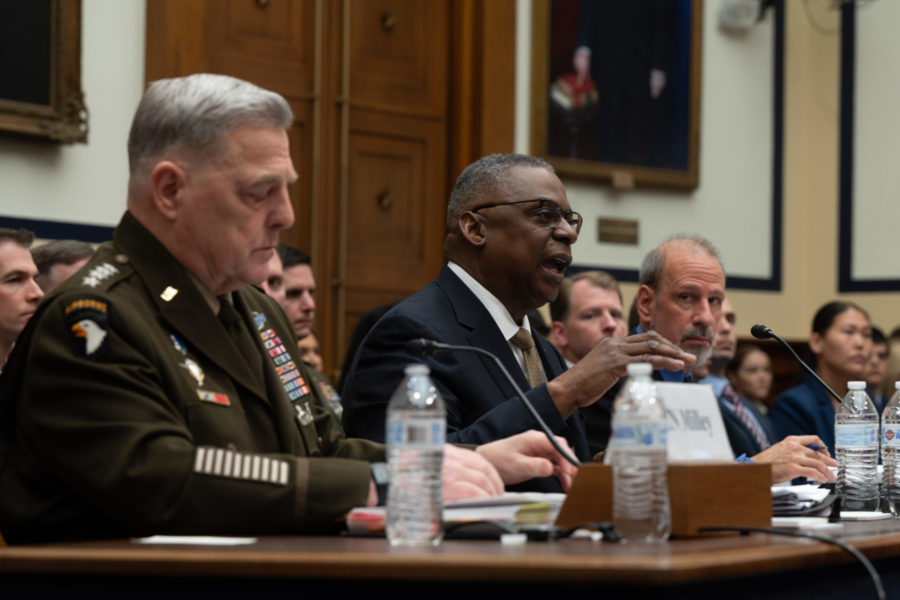Top U.S. defense officials dismissed the notion that the U.S. would provide aircraft—manned or unmanned—anytime soon to Ukraine in Congressional hearings March 28 and 29.
While Kyiv has repeatedly asked for F-16 fighters and MQ-9 drones, the Biden administration has refrained from providing them and argued the systems would be of limited use to Ukraine in the current phase of its fight against Russia’s invasion.
Instead, U.S. officials argue Ukraine has more pressing needs such as air defense, armor, and artillery. They also contend that Russia’s own capable air defense systems would limit the utility and employment of manned aircraft.
“That air domain is a very hostile airspace because of the capability that the Russians have for air defense,” Secretary of Defense Lloyd J. Austin III told the Senate Armed Services Committee on March 28.
Much of the debate has focused on manned fourth-generation fighters, such as F-16s. Pentagon and White House officials have not ruled out providing them to the Ukrainians, but have suggested that such a move may only come after the war is over.
“That won’t help them in this current fight,” Austin said. “And will they have a capability at some point down the road? We all believe that they will, and what that looks like, it could look like F-16s, it could look like some other fourth-generation aircraft.”
Poland and Slovakia have recently said they are providing 17 Soviet-era MiG fighters to Ukraine. The top U.S. Air Force leader in Europe, Gen. James B. Hecker, said those aircraft would mark a helpful capacity boost to Ukraine, which has already lost about 60 planes, but they will not significantly change battlefield dynamics. The U.S. is also providing an unspecified number of JDAM extended-range guided bombs for Ukraine’s air force.
Still, while members of Congress have expressed a willingness to send aircraft, Biden administration officials are holding out even as Ukraine prepares for a spring counteroffensive against the Russians.
Colin Kahl, the undersecretary of defense for policy, told Congress in late February that providing F-16s to Ukraine would be costly and time-consuming—older F-16s would cost at least $2 billion, he estimated. At least two Ukrainian pilots have traveled to the U.S. to evaluate their skills in simulators, U.S. officials have said.
“If you’re talking to F-16s, whenever you make that decision, in order to put together what needs to be put together to provide that capability is going to be 18 months or so in the making,” Austin said. “We will continue to work with our allies and partners to make sure that Ukraine has what it needs.”
Another system the U.S. has declined to provide is the unmanned MQ-9 Reaper drone. MQ-9s have been a hallmark of U.S. counterterrorism operations in the Middle East, most notably firing Hellfire missiles at targets. They have the ability to loiter for over 20 hours and gather intelligence.
They also appear to be available. The Air Force wants to divest 48 older MQ-9s in fiscal 2024, and the manufacturer of the aircraft, General Atomics, has pledged to provide its company-owned drones to Ukraine.
But the U.S. has instead opted to give Ukraine smaller tactical drones for ISR and strike missions, and both Austin and Gen. Mark A. Milley, the Chairman of the Joint Chiefs of Staff, said it would not be feasible for Ukraine to use MQ-9s.
“It is not a survivable platform if they try to use that in that environment,” Austin said.
A U.S. MQ-9 on a surveillance mission was downed recently over the Black Sea when a Russian fighter jet clipped its propeller while harassing the American drone, leading the USAF to crash it into the water.
“It’s big and slow,” Milley said of the MQ-9, which has a 20-meter wingspan and a cruising speed of about 230 miles per hour. “It’s going to get nailed by the Russian air defense systems. And in terms of its capabilities, I’m not sure what it’ll get you beyond the smaller, faster, more nimble UAV systems that we are providing, as well as some other countries are providing.”
Critics of the administration’s policy say MQ-9s would not have to go directly into Russian integrated air defense systems (IADS) to be useful to Kyiv.
“The proposed use of the MQ-9 is as a long-range sensing and targeting aircraft at a stand-off range—not to fly into the teeth of a fully robust and operational IADS,” retired Lt. Gen. David A. Deptula, dean of the Mitchell Institute for Aerospace Studies, told Air & Space Forces Magazine.
Moreover, Deptula argued, if the U.S. donated MQ-9s it planned to get rid of anyway, the aircraft could provide value to Ukraine even if they were shot down. For example, the drones could force Russia to expend air defenses of its own and could also highlight Russian radars so Ukrainian forces could attack them with air-to-surface missiles or surface-to-surface missiles, especially if the U.S. opted to provide Army ATACMS missiles to Kyiv.
Deptula—who planned the air campaign for Operation Desert Storm and the opening attacks of Operation Enduring Freedom—said that the administration appears to be “deterred by the concern of escalation” with Russia and is not “making choices that provide the best military advice for the Ukrainians.”
